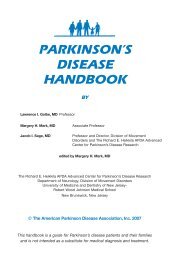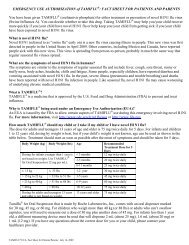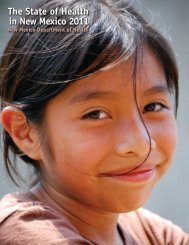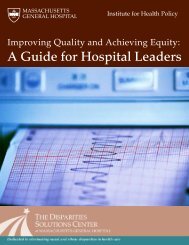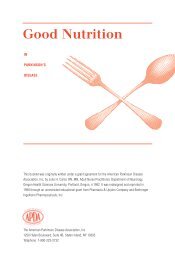Health Equity Quiz (pdf) - Unnatural Causes
Health Equity Quiz (pdf) - Unnatural Causes
Health Equity Quiz (pdf) - Unnatural Causes
Create successful ePaper yourself
Turn your PDF publications into a flip-book with our unique Google optimized e-Paper software.
sanitation and other protections that enlarged the middle class were central to expanding averageAmerican life expectancy. Death rates from tuberculosis, for example, fell by 70% even before the drugfor TB was discovered in 1948.Sources: (1) Vital Statistics Rates in the U.S. 1900-1940, U.S. Department of Commerce Report (dropped 76.4%).(2) Vital Statistics Rates in the U.S. 1900-1968, U.S. Department of Commerce Report 1900-1968, US Public <strong>Health</strong> Service,Vital Statistics of the United States, 1968, vol 2, part A, 1969-1970, unpublished data, provided to Sally Soliai by Karen DeniseThompson from the Census Bureau, Oct 18 th , 2006;(3) McKinlay, John and Sonja, “The Questionable Contribution of Medical Measures to the Decline of Mortality in the UnitedStates in the Twentieth Century,” Millbank Memorial Fund Quarterly. <strong>Health</strong> and Society (55:3) 1977.16. True or False? The gap between white and African American infant mortality rates is greatertoday than it was in 1950.A. True B. FalseANSWER: A. True. The total number of infant deaths among both African American and whiteAmericans has fallen since 1950. But today the infant mortality rate for African Americans is two and ahalf times that of white Americans, a greater gap than 60 years ago. In fact, the rate among AfricanAmerican mothers with college and professional degrees is higher than among white mothers whohaven’t finished high school. The only time the health gap between African Americans and whiteAmericans narrowed in both relative and absolute terms was after the Civil Rights victories of the1960s. But the gap began widening again in the 1980s.Sources: (1) Vital Statistics of the United States. (2002.) Centers for Disease Control and Prevention.(2) David, R. & J. Collins. (1997). “Differing Birth Weight among Infants of U.S.-Born Blacks, African-Born Blacks, and U.S.-bornWhites,” The New England Journal of Medicine, 337(17).(3) Randall, V. (2006). Dying While Black. Dayton, OH: Seven Principles Press.(4) Cooper et al. (1981) “Improved Mortality among U.S. Blacks, 1968-1978: the Role of Antiracist Struggle.” International Journalof <strong>Health</strong> Services, 11(4).17. Citizens of other industrialized countries have longer life expectancies and better health thanwe do because:A. They spend more on medical careB. They are more egalitarianC. They smoke lessD. They eat betterE. They have universal health care coverageANSWER: B. They are more egalitarian. On average, the smaller a country’s Gini coefficient (ameasure of income inequality), the better its health. The U.S. spends more than twice the average percapita among developed nations on health care, yet has the worst economic inequality in theindustrialized world and the worst health outcomes. Although universal health care coverage isimportant, its impact on health is less than the social conditions that make people sick in the first place.Social policies like living wage jobs, paid sick and family leave, guaranteed paid vacations, anduniversal preschool can shorten the ladder of inequality and offer protections from health threats tothose on lower rungs.18. The child poverty rate in Norway is 3.4%, France 7.5%, Hungary 8.8% and Greece 12.4%. Whatis it in the U.S?A. 4.1%B. 8.6%C. 12.8%D. 21.2%E. 32.4%ANSWER D. 21.2%. The U.S. has by far the most relative child poverty in the industrialized world.(“Relative poverty” is defined as households with income below 50 % of the national median income.)No one else even comes close. Interestingly, the French child poverty rate is 27.7% before taxes andtransfers, but falls to 7.5% after accounting for social programs. In Sweden, social spending drops thechild poverty rate from 18% to 4.2%. But the U.S. spends the least on social programs and as a resultour child poverty rate falls only a little, from 26.6% to 21.2%.Source: “Child Poverty in Rich Countries” (2005.) Innocenti Report Card No. 6. Report of the UNICEF Innocenti ResearchCentre, Florence, Italy. (http://www.unicef-irc.org/)© California Newsreel www.unnaturalcauses.org Page 5



